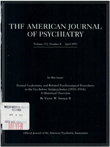Further distinctions between manic-depressive illness (bipolar disorder) and primary depressive disorder (unipolar depression)
Abstract
OBJECTIVE: Patients with bipolar disorder differ from patients with unipolar depression by having family histories of mania with an earlier onset and by having more episodes over a lifetime. This study was designed to determine whether additional aspects of course of illness, the presence of medical diseases, childhood traits, and other familial illnesses separate the two groups. METHOD: In a large collaborative study, consecutively admitted bipolar and unipolar patients were systematically given clinical interviews. Data were collected on medical diseases and childhood behavioral traits. Systematic family history and family study data were also obtained. The patients were studied every 6 months for 5 years. RESULTS: The group of bipolar patients had an earlier onset, a more acute onset, more total episodes, and more familial mania and were more likely to be male. These differences were relatively independent of each other. The bipolar patients were also more likely to have shown traits of hyperactivity as children. The unipolar patients had a significantly greater number of lifetime medical/surgical interventions than the bipolar patients, even when age was controlled. Alcoholism was more frequently found in the families of the bipolar patients, even when alcoholism in the probands was controlled; however, this difference was not significant. CONCLUSIONS: This study supports the usefulness of distinguishing between bipolar and unipolar patients in treatment and research studies.
Access content
To read the fulltext, please use one of the options below to sign in or purchase access.- Personal login
- Institutional Login
- Sign in via OpenAthens
- Register for access
-
Please login/register if you wish to pair your device and check access availability.
Not a subscriber?
PsychiatryOnline subscription options offer access to the DSM-5 library, books, journals, CME, and patient resources. This all-in-one virtual library provides psychiatrists and mental health professionals with key resources for diagnosis, treatment, research, and professional development.
Need more help? PsychiatryOnline Customer Service may be reached by emailing [email protected] or by calling 800-368-5777 (in the U.S.) or 703-907-7322 (outside the U.S.).



